The Best Case Study Examples
- 1. Adobe: Royal Bank of Scotland
- 2. BrightEdge: Stanley
- 3. LeadGnome: Host Analytics
- 4. Bitly: Vissla
- 5. Taboola: The Line
- 6. OutBrain: Lane Bryant
- 7. Google Analytics: Optimizely
- 8. LinkedIn: HubSpot
- 9. LevelEleven: Staples
- 10. Life Size: Rackspace
- 11. Five9: Weed Man
- 12. LogMeIn: Extent Technologies
- 13. Red Hat: North Carolina State Websites
- 14. VMWare: CenturyLink
- 15. HPE: Mendix
- 16. Gravitate: Global Expeditions Group
- 17. IDEO: INFARM
- 18. Forge and Smith: Happy Planet
- 19. CoSchedule: English Heritage
- 20. Slack: OpenAI
- 21. Square: The Epicurean Trader
- 22. Bluleadz: BandGrip
Building an effective content marketing strategy that can take your prospects through every stage of the buyer's journey means creating a variety of content.
From relevant, informative blog content to engaging webpages, landing pages, whitepapers, and emails, a comprehensive content marketing strategy should run deep.
One powerful, but often underused, piece of content is the case study.
What Is a Case Study?
A case study acts a narrative, featuring real-world situations where certain products or services are used in a way that demonstrates their value. They are a special type of thought leadership content that brands can use in marketing and sales to guide their target audience to the decision stage of their buyer's journey. Engaging case studies walk prospects through how a real life customer identified a specific pain point, started using your product or service, and overcame that pain point while reaping additional benefits.
A case study is a unique type of thought leadership content that tells a story.
Case studies are narratives that feature real world situations or uses of products or services to demonstrate their value. A well written case study will follow a customer as they define a problem, determine a solution, implement it, and reap the benefits.
Case studies offer readers the ability to see a situation from the customer's perspective from beginning to end.
Need an example of a case study? Check out some of our case studies here!
Why Case Studies Are Important
A marketing case study is one of the most compelling content items in your sales funnel.
It’s the perfect way to guide people into and through the decision phase, when they have the best options laid out on the table and they’re ready to puzzle through that final selection.
Because of this, case studies are uniquely useful as bottom of the funnel content.

By the time prospects are ready to read case studies, they have a nuanced grasp of the problem in front of them. They also have a good selection of potential solutions and vendors to choose from.
There may be more than one option that’s suitable for a given situation. In fact, there usually is. But there’s just one option that fits the prospect best. The challenge is figuring out which one.
Since B2B decision makers aren’t mind readers, they need content to bridge the gap between “what they know about your solution” and “what they know about their own business.” The case study does that by showing how a similar customer succeeded.
The more similar the prospect is to the customer in the case study, the more striking it will be.
For that reason, you might want to have a case study for every buyer persona you serve. And naturally, case studies pertain to specific products or services, not your whole brand.
So, you could find yourself with multiple case studies for each buyer type.
However, the effort is worth it, since case studies have a direct impact on sales figures.
How Long Should a Case Study Be?
Honestly, the more to-the-point you can be in a case study, the better.
Great case studies should pack a lot of meaning into a small space. In the best examples, your reader can grasp the single main idea of each page in a short paragraph or two.
Each detail should build on the next, so they’ll keep moving forward until the end without getting distracted.
Sure, it’s no Dan Brown novel, but if you do it right, it’ll still be a real page-turner.
Note: Some businesses will have a brief case study in PDF form to use as sales collateral then a longer form, more in-depth version of the same case study on their website. In this case, it can be normal to write a lengthier case study.
Where Should I Put My Case Studies?
Anywhere you want, really!
Ideally, you should upload case studies somewhere on your website so new leads coming to your site have the opportunity to see just how kickass your business is at driving revenue and results for your current customers.
Whether it's an online case study or a PDF version, making your successes available to the public can prove just how valuable your efforts are.
Plus, make sure every member of your sales team has access to your case studies so they can use them as sales collateral to send to prospects and opportunities! A quick PDF attachment to a sales email can be very convincing.
It can also help to sprinkle links and CTAs to your case studies throughout your content:
The Best Case Study Format
- Introduction: Provide context for the story.
- Challenge: Describe the primary issue being faced.
- Solution: Identify the product or service being used.
- Benefit: Emphasize the most impactful advantages.
- Result: Detail the specific outcomes the customer earned.
Like press releases, case studies often fall into a certain specific format.
While it’s not required that you have all of the possible topics in a particular order, picking a consistent format will help you accelerate production down the road. It also makes your content easier to read.
Many B2B businesses use the following approach:
- Introduction: sets the stage by providing context for the situation.
- Challenge: discusses the key problem that the customer was facing.
- Solution: a basic overview of the product or service the customer used.
- Benefit: recaps the solution’s top advantages – why it was the right choice.
- Result: the positive business outcome arising from the solution and benefits.
This formula gives you enough flexibility to highlight what’s most important about your enterprise, solution, and the customer you’re showcasing.
At the same time, it ensures that your team will know exactly what information they need to compile to design case studies in the future.
It also serves as an intuitive trail of breadcrumbs for your intended reader.
How to Write a Case Study

1. Ask Your Client/Customer for Approval.
This first step is crucial because it sets the layout for your entire case study.
If your client or customer gives the ok to use their name and information, then you can add as much detail as you want to highlight who they are, what you helped them do, and the results it had.
But, if they would rather remain anonymous or want you to leave out any specific details, you’ll have to find a way to keep your information more generalized while still explaining the impact of your efforts.
2. Gather Your Information.
Like any good story, a marketing case study has a beginning, middle, and end. Or, you could think of it as “before, during, and after.”
Before: The Problem
Your case study will always open by presenting a problem suffered by one of your clients.
This part of the study establishes what’s at stake and introduces the characters – your company, the client company, and whichever individual decision makers speak for each side.
During: The Solution
Once you define the problem, the next step presents your offering, which serves as the answer to the dilemma.
Your product or service is, in a very real sense, the hero of the story. It catalyzes the change, which you describe in terms of your features, advantages, and other differentiators.
After: The Result
In the final step, you discuss the “happy ending” brought about by your solution.
Returning to the “stakes” you established at the very start, you expand on how much better things are thanks to your intervention. You want prospects to imagine themselves enjoying that level of success.
3. Get a Quote.
Of course, a study about two corporations isn’t very interesting on its own. The best case studies personify the protagonists, including the vendor and the client company, by having plenty of quotes peppered throughout the entire story.
Naturally, the business problem to be solved is the big, bad villain here, so you want the client (and preferably, your own team as well) to weigh in on that problem: How complex it is, what solving it would mean, and what not solving it would cost.
Then, as the situation turns around, testimonials become essential.
Naturally, the longest, most emphatic testimonial should come from the top decision maker. But you should aim to include a glowing quote from many different stakeholders – representing the full cast of “characters” who might be making consensus buying decisions around your solution.
Note: Don’t use a testimonial or quote if your case study is anonymous.
4. Find Some Compelling Graphics.
A case study isn’t a whitepaper: You shouldn’t be trudging through page after page of text.
In fact, some of the most powerful case studies establish their own vivid, graphics-heavy style – looking a lot more like an infographic, or even a magazine, than traditional B2B marketing collateral.
Color blocks, strong contrasts, skyscraper photography, and hero shots are all on the table when it comes to case studies. The more data you have to convey, the more creative you should be in presenting it so it can be understood at a glance.
15 Great Examples of Offline Case Studies
1. Adobe: Royal Bank of Scotland
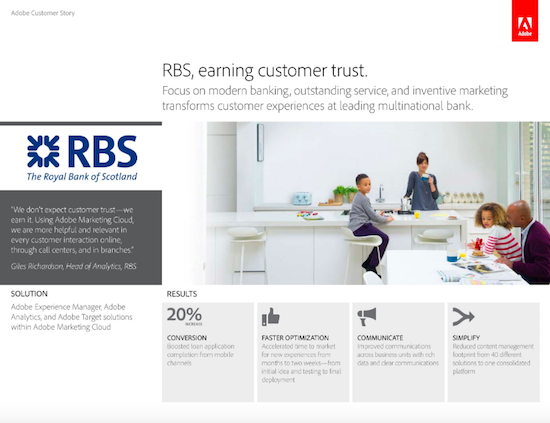
Source: DocSend
This study focuses on the solutions Adobe provided for the Royal Bank of Scotland. Their top challenges included fostering a culture of data driven decision making, eliminating disjointed systems, and delivering digital experiences that are relevant and easy to use.
Adobe's approach resulted in a 20 percent increase in conversion, as well as improved internal communications, faster optimization, and a reduction of their content management footprint.
2. BrightEdge: Stanley
In 2015, Stanley consolidated two separate brand web properties into one site. The process needed to mitigate traffic disruption, improve traffic, and increase organic search results.
The results? Almost 40 percent of keywords Stanley ranked for were on the first page of organic results, and the company generated a 100 percent lift in revenue, thanks to support from the BrightEdge platform.
3. LeadGnome: Host Analytics
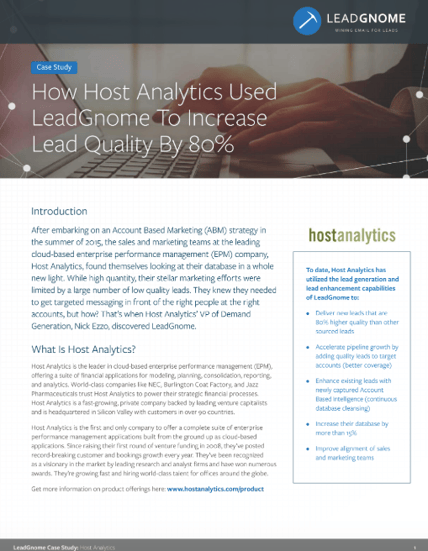
Source: DocSend
Host Analytics moved to an account based marketing strategy in 2015. They noticed that the marketing efforts were limited by a large number of low quality needs.
Their problem was solved when they used an automated email marketing approach from LeadGnome to nurture and qualify leads via email marketing.
4. Bitly: Vissla
Vissla is an online ecommerce company with a need to understand big data across multiple marketing platforms.
Bitly provided a a way to consolidate data and literally link channels together to display all information on a single dashboard.
5. Taboola: The Line
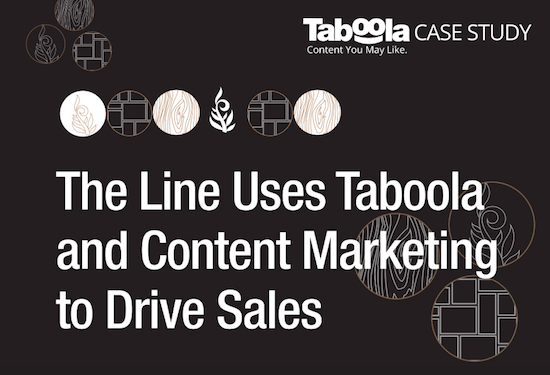
Source: DocSend
The Line is an online boutique that offers shoppers a unique experience and showcases products that can be found at their brick and mortar store in NYC's Soho neighborhood. Their goal was to increase first time visitors to their site.
Taboola offers a product that drives first time users. The result? Over 72 million impressions within three months, and email subscriber growth of 12 percent.
6. OutBrain: Lane Bryant
Lane Bryant, the leading retailer for women sized 14 – 28, launched a campaign designed to celebrate all women and redefine the traditional notion of sexy with a simple message – ALL women are sexy.
The goal was to amplify the campaign and drive traffic and engagement.
The result? OutBrain used media amplification to take the campaign viral, resulting in over 48,500,000 impressions in just two weeks!

7. Google Analytics: Optimizely
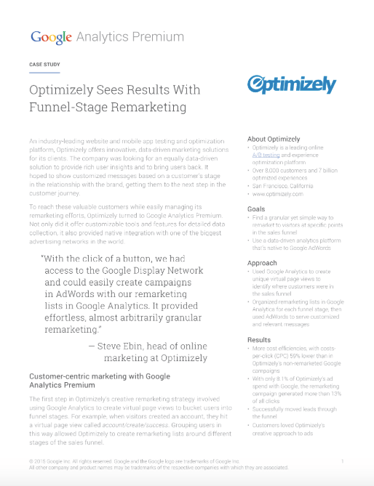
Source: DocSend
Optimizely is a leading online A/B testing and user experience optimization platform that offers innovative data-driven marketing solutions to maximize user experience and keep them coming back for more.
The challenge they faced was better identifying page views to determine where customers are in the buying cycle.
The solution was provided by using data from Google Analytics Premium to successfully move leads through the sales funnel.
8. LinkedIn Marketing Solutions: HubSpot
HubSpot, in search of quality leads, turned to LinkedIn Marketing Solutions to engage with marketing professionals in small to medium sized businesses, targeting them with ebooks, webinars, and how-to guides. Sponsored organic content appeared in members' LinkedIn feeds.
The result: 400 percent more leads within their target audience than efforts on other platforms.
9. LevelEleven: Staples
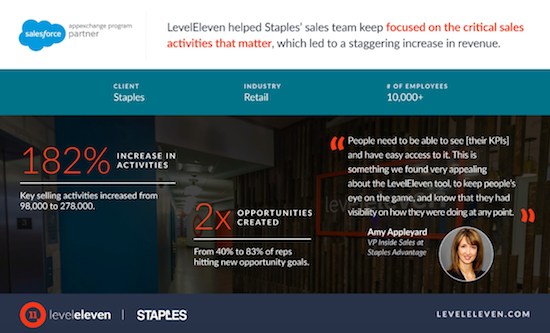
Source: DocSend
LevelEleven helped Staples focus their teams on the critical sales activities that matter.
The end result? Their team developed a better understanding of the KPIs that matter and experienced a 182 percent increase in key selling activities.
10. LifeSize: Rackspace
Rackspace is a world leader in hybrid cloud computing with offices throughout the world. The challenge was collaborating and communicating across offices.
The approach? LifeSize created a video solution to build stronger relationships across international offices.
11. Five9: Weed Man
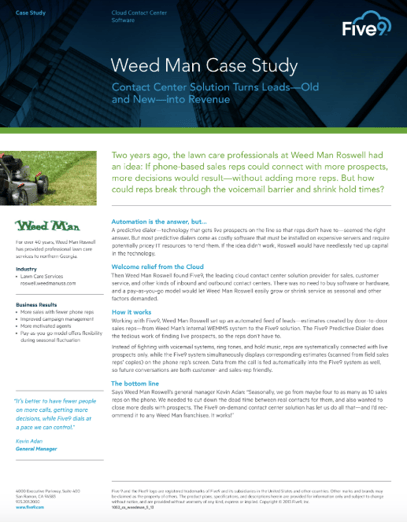
Source: DocSend
Five years ago, the lawn care company Weed Man had an idea -- If their phone-based reps could connect with more prospects, more decisions would result, without adding sales reps.
The solution? Five9 assisted Weed Man with migrating their data to the cloud. This case study shows why SMBs like Weed Man should store business data on the cloud for CRM.
12. LogMeIn: Extent Technologies
One of the better, more concise case study examples, this one page synopsis clearly defines the challenges and goals of Extent.
It explores how LogMeIn provided effective solutions and produced stellar results, including a boost in staff productivity, an increase in first contact resolution rate, and an improvement in overall service.
13. Red Hat: North Carolina State Websites
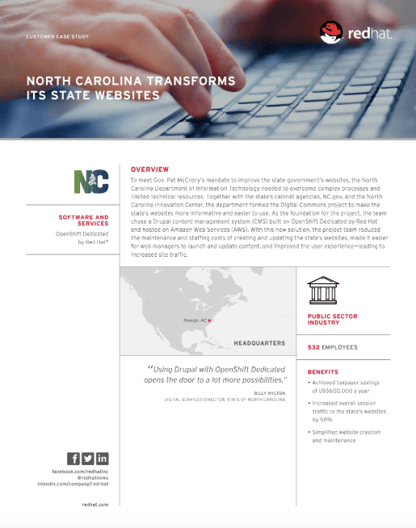
Source: DocSend
Under mandate from the governor, the North Carolina Department of Information Technology needed to update state websites to overcome complex processes and limited technical resources.
The resulting solutions from Red Hat reduced maintenance times and lowered staffing costs.
14. VMWare: CenturyLink
This study addresses the complexities of cloud hosted infrastructure. One element of all case study examples is to educate perspective clients about the services and products offered.
This study takes a complex subject and makes it easy to understand, while clearly outlining the solutions VMWare can provide.
15. Hewlett Packard Enterprise: Mendix
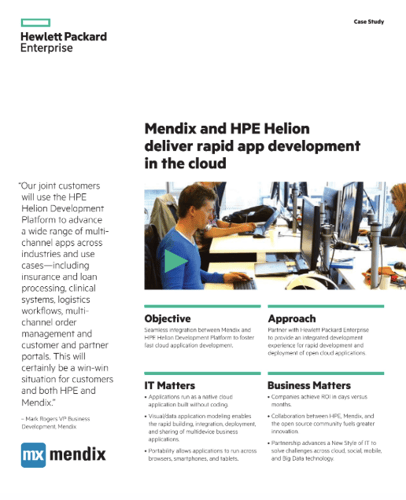
Source: DocSend
This study breaks down another complex subject: rapid hosted cloud app development.
HPE links to additional content so readers can gain even more knowledge about the subject and the solutions HPE offers.
7 of the Best Online Case Studies
1. Gravitate: Global Expeditions Group
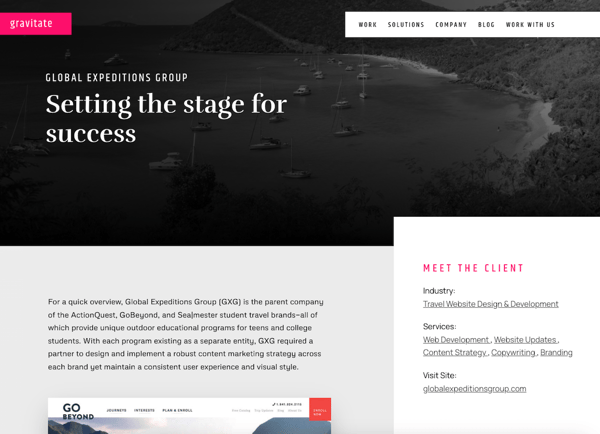
This case study is a great example of how to break up a detailed case study for an easier read.
Gravitate starts off by introducing their client, Global Expeditions Group (GXG), to give visitors a little background into what they do. They then dive straight into what their role was in helping GXG with a robust content marketing strategy.
What catches your eye at the beginning of this case study is the results. Rather than forcing readers to find out the impact of their efforts at the very end, they call out some major statistics and improvements that they helped GXG achieve. It's a great way to entice readers to keep them wanting to learn just how they did it.
Gravitate did a great job breaking up their rather long case study. Since it focuses on an entire content marketing strategy, they put various parts of their case study into separate sections, from their rebranding efforts to their website design and copywriting.
2. IDEO: INFARM
What we like so much about IDEO's case study about INFARM is that it reads just like a simple blog post – there's no sections and no busy graphics. While this doesn't work for everyone, it really matches the vibe of IDEO's brand.
This case study is short, sweet, and to the point, with the largest elements on the page being the images and a quote. At the very top, they outline the entire case study in two small sections – the challenge and the outcome.
What we like about this particular case study is how IDEO talks about what's next for INFARM. Beyond the typical problem-solution-result structure, they took it one step further to talk about the future and what INFARM plans on doing next.
3. Forge and Smith: Happy Planet
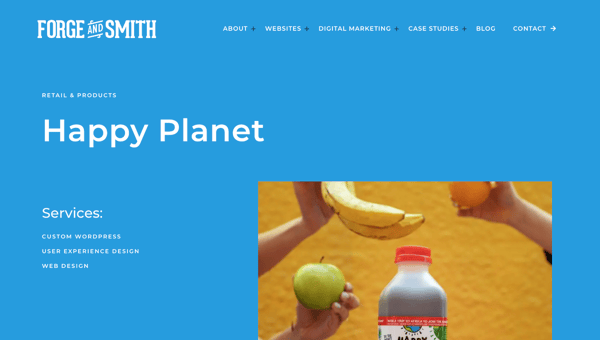
Forge and Smith effectively uses real mockups and examples from the work they did for Happy Planet to showcase their work in action.
This case study is perfectly designed into multiple modules to break up chunks of text into three phases. They start off with the objectives they set in place for their website design and development work for Happy Planet, which is pretty unique for a case study.
What's great about this case study is the opportunity to view the finished website. A hyperlink isn't just hidden within the text forcing you to dig around looking for it; it's called out right then and there to let you view their finished work on the Happy Planet website.
Another great feature is the option to view a previous case study or all the case studies if you're interested. No need to locate the main page, you have direct access!
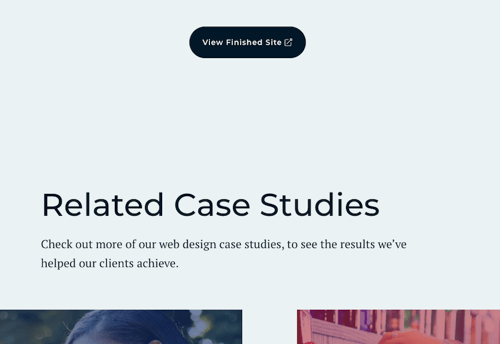
4. CoSchedule: English Heritage
CoSchedule treats their case studies as customer stories, highlighting who their customers are and how their platform was able to help them. Their case study on English Heritage is simple to view and comprehend.
On the left, there is a customer spotlight on English Heritage, complete with a company logo, brief description, industry, company size, size of the marketing team, and more. These little details help give you a better idea of who the company is.
Then, on the right side of the screen, is a blog-like case study.
Rather than breaking up their message into the standard format, CoSchedule calls out the results that English Heritage has seen since switching to CoSchedule. Within each result, they touch on the challenge they had before CoSchedule then the lasting impact it created.
Throughout the case study, CoSchedule includes relevant screenshots and impactful quotes from English Heritage employees. This helps readers visualize what they are talking about.
5. Slack: OpenAI
Artificial Intelligence (AI) tools have quickly claimed center stage in the digital world. Slack is one business that hopped on the bandwagon and incorporated AI generated assistance into their platform, and this case study tells a story of success using modern technology.
In this case study, Slack relies heavily on testimonials to share the impact that OpenAI has made on their product. The story of Slack and OpenAI is told directly to readers by the people who experienced the partnership and how it can improve user experience for all kinds of businesses. Sharing a success story in this way makes the whole case study feel much more personal than just providing a list of statistics.
When customers read through the case study, they'll get to know perspectives from multiple people, hopefully coming across one that really resonates with them.
6. Square: The Epicurean Trader
The Epicurean Trader case study featured on the Square website follows the tried and true structure for a closer look into a success story. First, this case study introduces The Epicurean Trader and what problems they were facing as a retail business.
The next section of the case study discusses the solution proposed by Square and the implementation of their products as The Epicurean Trader expanded their business. Finally, this case study concludes with notable impacts as a result of using Square's software, including revenue growth and comparisons to standards set within the industry.
Reading through this case study, you'll join The Epicurean Trade on their journey to enhance their retail practices. Thanks to testimonials from the owner of the business, you'll also get an inside look at how this brand was able to grow with some help from Square.
Overall, this case study example is clear, concise, and easy to follow. Readers will get to know a highlighted business and how Square stepped in to resolve a problem they were facing.
7. Bluleadz: BandGrip
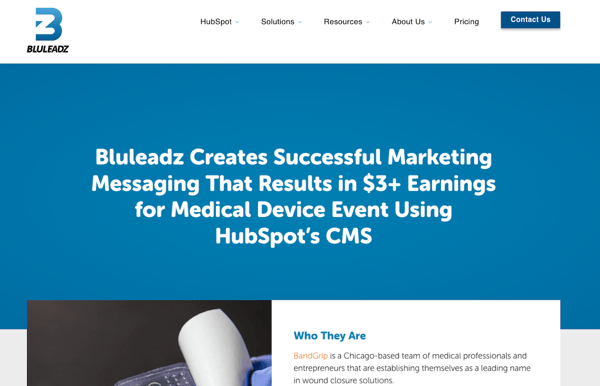
We couldn't not pat our own backs for recently publishing a case studies page on our website.
Bluleadz often uses case study PDFs as sales collateral to send to qualified prospects. While we used these PDF designs internally, we wanted to make sure our client success stories were available to everyone coming to our site.
Thus, our case study page was born.
Our BandGrip case study really sticks out to us. We start off by introducing who BandGrip is, who they serve, and what they do.
Then, we highlight the struggles they were having with getting demo sign-ups on their page. We included relevant quotes from the CEO to show their need for a solution.
We then begin to outline all the pre-show and post-show tactics that we implemented to help them tackle their challenge and earn them more demo sign ups. Landing page screenshots and other various graphics help readers visualize what we were able to do.
Toward the end of the case study, we highlight the impact of our efforts, calling out some of the major statistics.
Highlight Your Past Successes to Attract Future Business
Each of these case study examples does an excellent job of outlining the challenges, solutions, and results provided. If you are building a portfolio of case studies, use these excellent examples for inspiration and format.
Once you master the art of the case study, you’ll find it’s packed with marketing power, giving you a huge ROI for the time you put into creating it.
If your leads have been falling off in the decision phase, a marketing case study may be just what you need.
Case studies are a powerful tool in your content marketing arsenal, so why not create one today? Click below to create your very own case study!




Jackie Jacobson
Jackie is a Copywriter at Bluleadz. She graduated from Elon University with a degree in Creative Writing and is currently living in Charlotte, NC. If you need her, you can find her exploring the city or relaxing with a good book.